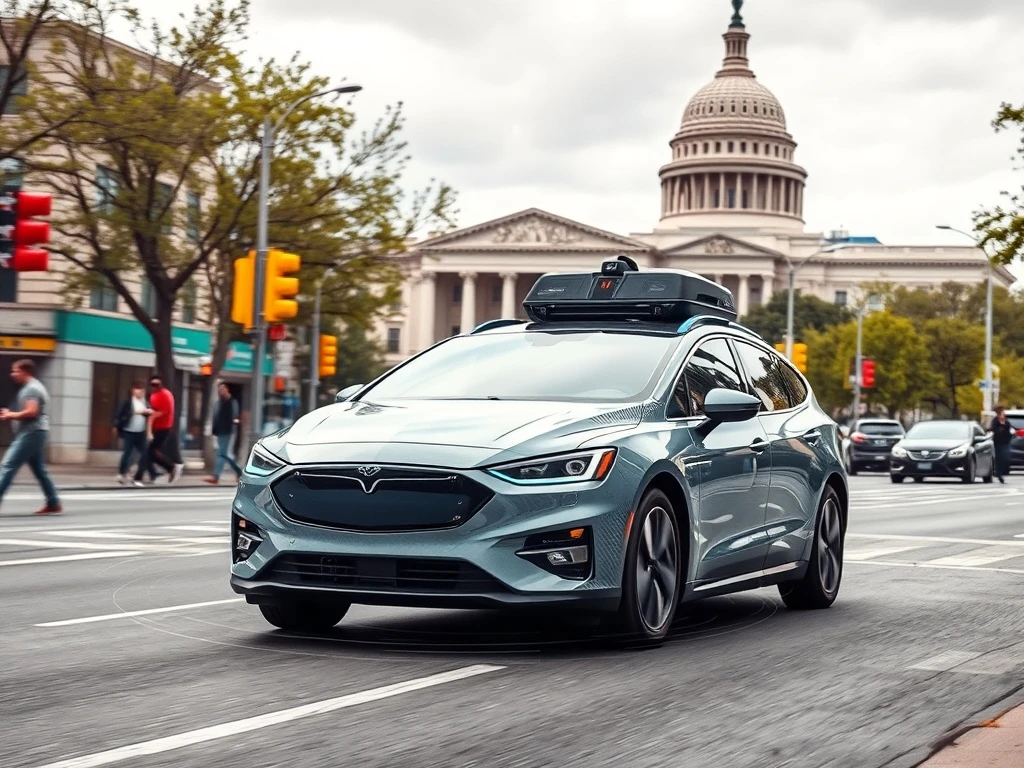Waymo Self-Driving Unleashed: NHTSA Probe Concludes, Paving Way for Confident Expansion

In the rapidly evolving world of technology, where innovations like blockchain and AI are constantly pushing boundaries, the progress of autonomous vehicles stands as a testament to human ingenuity. Just as decentralized finance seeks to redefine traditional banking, self-driving cars aim to revolutionize transportation. Recently, a significant milestone was reached for Alphabet Inc.’s Waymo, as the U.S. National Highway Traffic Safety Administration (NHTSA) concluded a 14-month probe into its Waymo self-driving robotaxis, identifying no systemic safety issues. This outcome is not just a win for Waymo but a pivotal moment for the entire autonomous vehicle industry, signaling a growing regulatory confidence in this transformative technology.
The NHTSA Investigation: What Did It Uncover?
The NHTSA investigation, initiated in May 2024, meticulously reviewed 22 incidents involving Waymo vehicles. These incidents ranged from minor collisions to instances of unexpected behavior, such as sudden stops or erratic lane changes. The probe aimed to ascertain whether these occurrences pointed to deeper, systemic flaws in Waymo’s autonomous driving systems. For over a year, regulators scrutinized every detail, looking for patterns that might indicate a fundamental safety concern.
Key aspects of the probe included:
- Incident Review: Detailed examination of 22 reported incidents, focusing on vehicle behavior and environmental factors.
- Allegations Scrutiny: Investigation into claims of traffic rule violations or erratic actions by Waymo vehicles.
- Corrective Actions: Evaluation of Waymo’s responses, particularly its voluntary recalls and software updates.
The conclusion, announced in July 2025, was clear: no systemic safety issues were identified. This determination was heavily influenced by Waymo’s proactive measures, which included two voluntary recalls aimed at addressing specific concerns. This approach by Waymo, prioritizing transparency and swift action, proved crucial in the regulatory body’s decision.
Enhancing Autonomous Vehicles Safety Through Proactive Measures
Waymo’s response to the incidents highlighted a commitment to autonomous vehicles safety that resonated with NHTSA. The company didn’t wait for punitive measures; instead, it took the initiative to implement significant improvements. These proactive steps are a blueprint for how tech companies can navigate regulatory scrutiny in emerging fields.
Here’s a closer look at Waymo’s key actions:
- First Recall (Early 2024): Followed an incident involving a utility pole. This recall focused on software updates to prevent similar occurrences, demonstrating a rapid response to a specific challenge.
- Second Recall (May 2025): Addressed difficulties navigating construction zones and better detecting barriers and road gates. This showed an ongoing commitment to refining obstacle detection, a critical component of safe autonomous driving.
- Software Updates: Continuous refinement of AI algorithms to improve perception and decision-making, ensuring the vehicles can better interpret complex urban environments.
NHTSA specifically noted that several incidents involved collisions with clearly visible objects, which a competent human driver would typically avoid. This observation underscores the ongoing challenge of achieving human-level perception and reaction in AI systems. However, Waymo’s subsequent software enhancements and ongoing technical collaboration with regulators showcased a strong commitment to closing this gap.
The Future of Self-Driving Technology: Building Trust and Expanding Horizons
The closure of the NHTSA investigation marks a significant vote of confidence in self-driving technology, especially for Waymo. With over 1,500 autonomous vehicles operating across various U.S. cities, Waymo is a frontrunner in this space. This regulatory clearance provides a solid foundation for the industry to build public trust, which remains a critical barrier to widespread adoption.
The regulatory approach taken by NHTSA—emphasizing data analysis and voluntary compliance over strict punitive measures—reflects a broader trend of balancing innovation with public safety. This outcome may encourage other autonomous vehicle developers to adopt similar strategies, fostering a collaborative environment between industry and regulators. It highlights that proactive problem-solving and transparency are key to navigating the complex landscape of emerging technologies.
Waymo Expansion: Navigating New Territories and Challenges
With the NHTSA probe behind it, Waymo is poised for significant Waymo expansion. The company has ambitious plans to extend its services to major U.S. cities, including Atlanta, New York, Miami, and Washington, D.C., through a mix of partnerships and direct rollouts. This expansion will bring the convenience and potential safety benefits of autonomous ride-hailing to millions more people.
However, expansion isn’t without its hurdles:
- Local Legislation: Cities like Boston are actively reviewing legislation to govern autonomous vehicles, indicating that regulatory challenges extend beyond federal oversight. Public acceptance and local government buy-in are paramount.
- Public Acceptance: Despite technological advancements, public skepticism about self-driving cars persists. Minor incidents, even if not systemic, can erode trust. Continuous education and transparent communication are vital.
- Complex Urban Environments: Each city presents unique challenges, from varied road conditions and traffic patterns to diverse pedestrian behaviors. Waymo’s systems must adapt and perform flawlessly in these new, complex settings.
Waymo’s cautious approach to market entry, exemplified by its measured plans for Boston, reflects the industry’s understanding that technical compliance is just one piece of the puzzle. Gaining public acceptance and seamless integration into urban infrastructure are equally crucial for long-term success.
A New Era for Autonomous Transportation
The resolution of the NHTSA investigation is more than just a regulatory formality; it’s a powerful endorsement of Waymo’s safety protocols and its proactive approach to development. This outcome sets a precedent for how emerging technologies, from AI-driven vehicles to decentralized blockchain networks, can collaborate with regulatory bodies to ensure public safety while fostering innovation. It underscores the critical need for continuous refinement of AI-driven safety systems and transparent corporate accountability. As Waymo moves forward with its expansion plans, its journey will undoubtedly continue to shape the future of autonomous transportation, offering valuable lessons for other tech sectors navigating similar paths.
Frequently Asked Questions (FAQs)
Q1: What was the primary outcome of the NHTSA investigation into Waymo?
The NHTSA concluded its 14-month investigation into Waymo’s self-driving vehicles without identifying any systemic safety issues. This decision was largely based on Waymo’s proactive measures, including two voluntary recalls and software updates to address concerns.
Q2: How did Waymo address the concerns raised during the probe?
Waymo implemented two voluntary recalls. The first recall in early 2024 addressed incidents like collisions with utility poles, while the second in May 2025 focused on improving obstacle detection for barriers and construction zones through software updates.
Q3: What does this decision mean for the future of autonomous vehicle safety?
The NHTSA’s decision signals increased regulatory confidence in autonomous vehicle safety. It highlights the importance of proactive problem-solving, data transparency, and collaboration between developers and regulators in ensuring the safe integration of self-driving technology.
Q4: What are Waymo’s plans for expansion following the probe’s conclusion?
Waymo plans to expand its services to new major U.S. cities, including Atlanta, New York, Miami, and Washington, D.C., through partnerships and direct rollouts. This expansion will significantly increase its operational footprint.
Q5: Are there still challenges for Waymo despite the positive NHTSA outcome?
Yes, challenges remain. These include navigating diverse local legislations (as seen in Boston), continuing to build public trust, and adapting its technology to the unique complexities of different urban environments.










